This post may contain affiliate links.
This simple and delicious Spring Pea and Asparagus Risotto recipe is a great weeknight dinner that packs in spring vegetables. Roasted asparagus adds the perfect flavorful veggies! Full of flavor with parmesan, a touch of butter and white wine. Dinner is comforting and veggie packed!
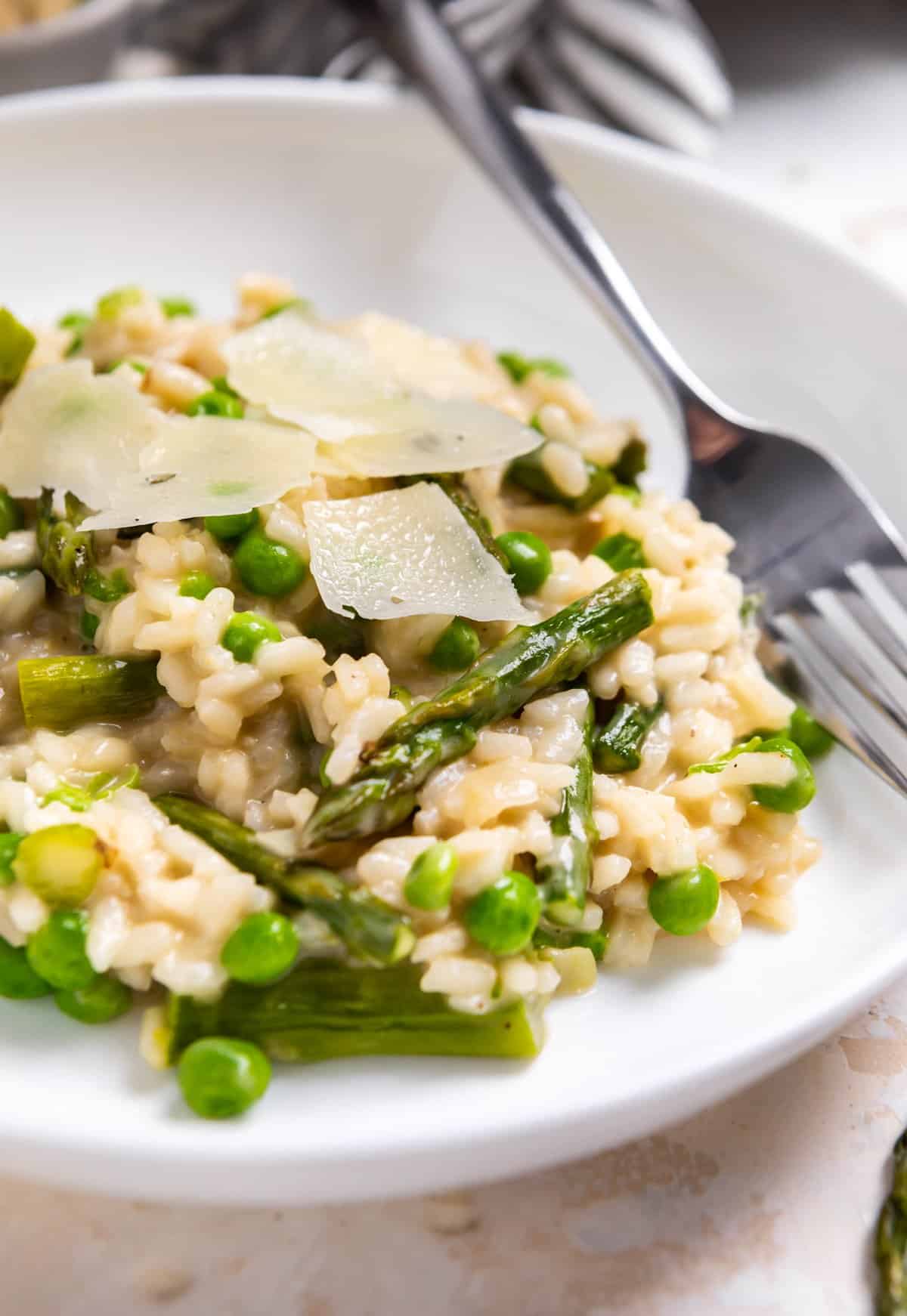
Risotto is a simple and cozy dish, and with some spring vegetables, this one brings vibrant flavors that can be enjoyed even when the weather is warm.
Don’t be intimidated by making this kind of dish–it’s seriously so easy!
If you love peas and asparagus, try this Spring Green Salad!
Why You Will Love This Pea and Asparagus Risotto:
- Lots of fresh veggies. Asparagus and peas–two great green veggies to add to any meal. Sure I said fresh, but I use frozen peas as I eat them by the bowlful all the time. You could add other vegetables as well to this risotto. Mushrooms are another great addition.
- Simple ingredients. Aside from the arborio rice, I typically have almost everything on hand for this pea and asparagus risotto. In fact, asparagus is the only ingredient I don’t always have on hand but I have made this risotto dish without it before and still enjoyed it immensely.
- It’s a pasta like dish that is naturally gluten free. Since arborio is a rice, it is naturally gluten free. That means if someone in your family is gluten intolerant or can’t consume gluten, it can be enjoyed by everyone!
Recipe Ingredients:
- arborio rice: you will find it in the rice section of the grocery even though risotto seems like a pasta
- broth: broth or stock is great. I like chicken broth but vegetable broth is great too. Low or reduced sodium is my preference as well and then I have control over how much salt is in the pea and asparagus risotto in the end.
- white wine: I prefer a dryer white wine. Pinot grigio is typically my go to cooking wine. You can omit the wine if it’s not something you enjoy. The alcohol will be cooked out so it can be served to children. The wine helps balance the rich flavors of risotto. You can add a splash of white wine vinegar instead if preferred. Or just omit it!
- butter: unsalted butter, and you can stir in 1-2 tablespoons in the end, per your preference.
- garlic: freshly minced for the most flavor.
- shallot: if you don’t have a shallot, about 1/4 cup minced onion will work as well
- olive oil: a drizzle for the asparagus
- asparagus: fresh for the best roasted asparagus
- peas: frozen is my preference, unless you can get a hold of fresh. You don’t even have to thaw.
- lemon: a touch of fresh juice and zest adds lots of flavor
- parmesan: grated or freshly shredded are both ideal. They will stir in and melt nicely.
- salt/pepper: add this to taste
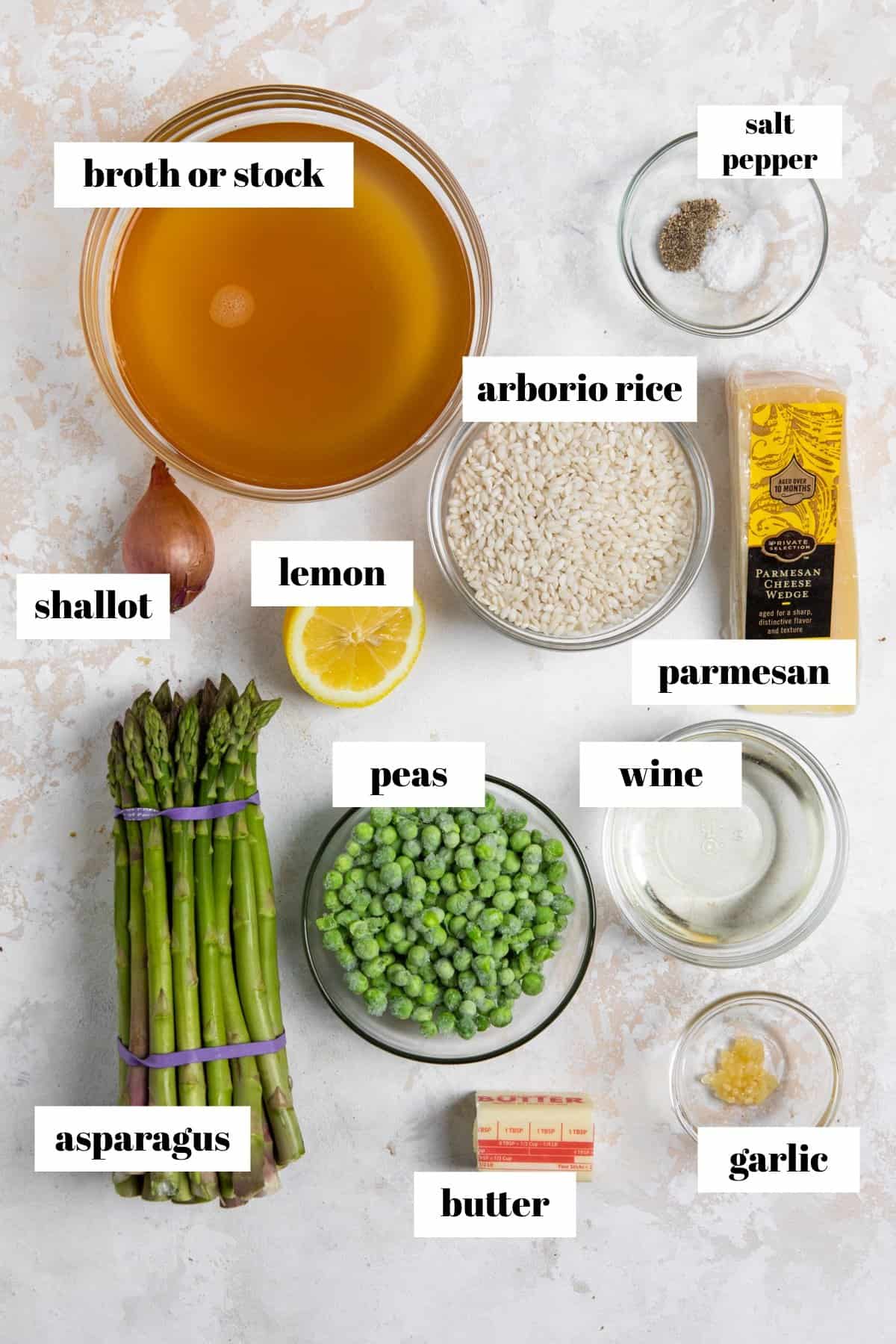
Step-By-Step Instructions:
Start by prepping the asparagus. Chop it into bite sized pieces. Toss it in a drizzle of olive oil. You can season with salt, pepper and garlic powder as desired. I usually toss a touch of each.
Line on parchment lined sheet pan. Roast for about 12-15 minutes at 425°F or until they start to brown and soften.
- While the asparagus cooks, add all of your broth to a sauce pan and heat over medium heat until warmed. Then melt two tablespoons of butter in a separate large skillet or pan over medium heat. Add in the shallot and sauté for several minutes until they begin to become translucent. Add in the garlic and stir another minute.
- Add in the arborio rice and toast for one to two minutes, stirring constantly.
- Pour in the wine and allow it to absorb into the rice while stirring. Begin adding a ladle full of warmed broth into the skillet and stir until it is absorbed.
- Continue adding ladles of broth until almost all of the broth is used and the rice is tender with a slight bite in the middle. Adjust the heat of the stove to keep the risotto at a simmer and make sure it doesn’t start to boil. It will take about 20 minutes give or take for all the broth to absorb and the rice to soften.
- When the rice is al dente, add in one last ladle of broth, the remaining butter, parmesan cheese, lemon juice and stir well until the risotto is creamy but not soupy.
- Add in the peas and roasted asparagus and stir until peas are cooked. Serve immediately with parmesan and chopped parsley and a touch of lemon zest if desired.
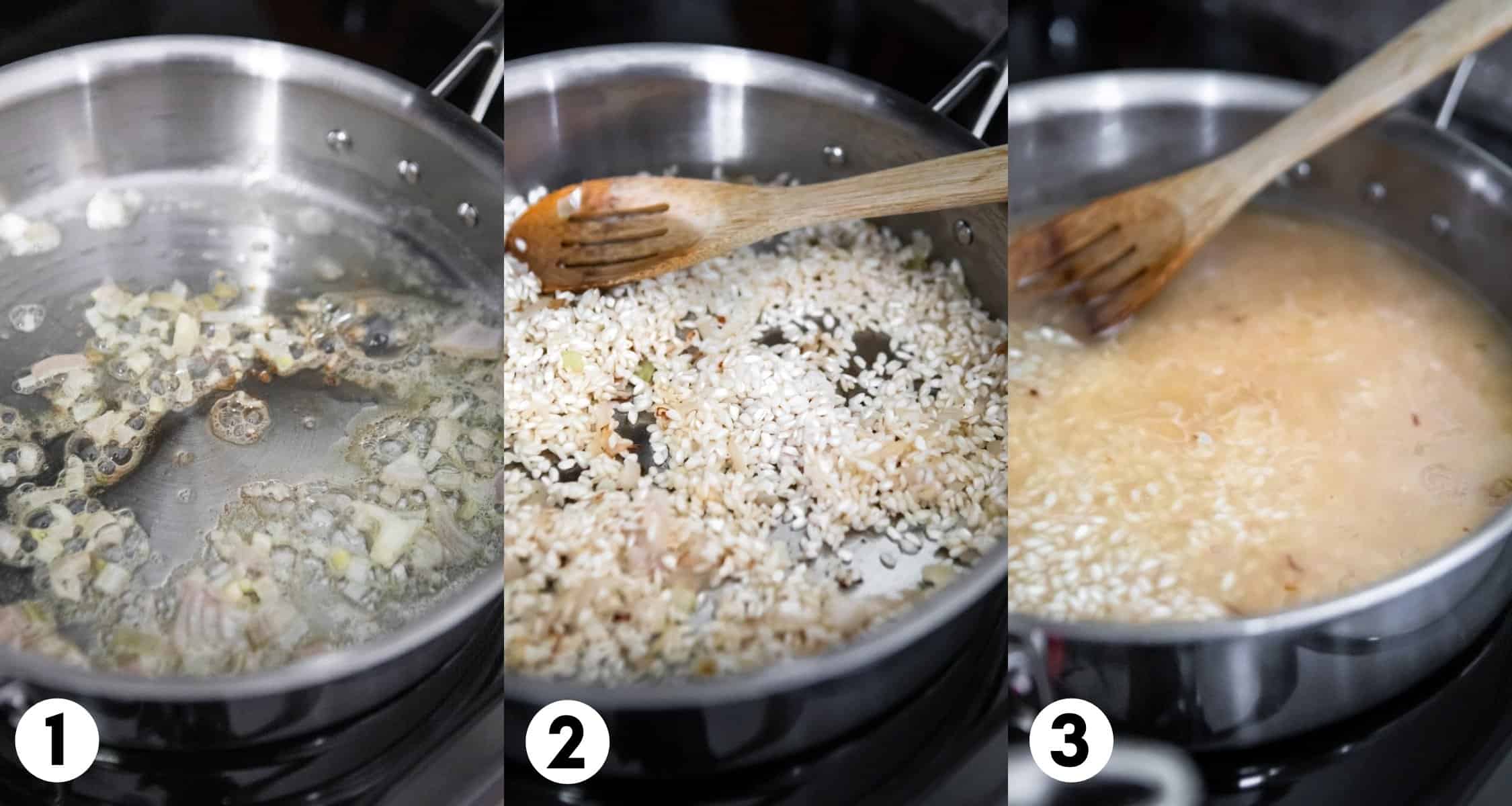
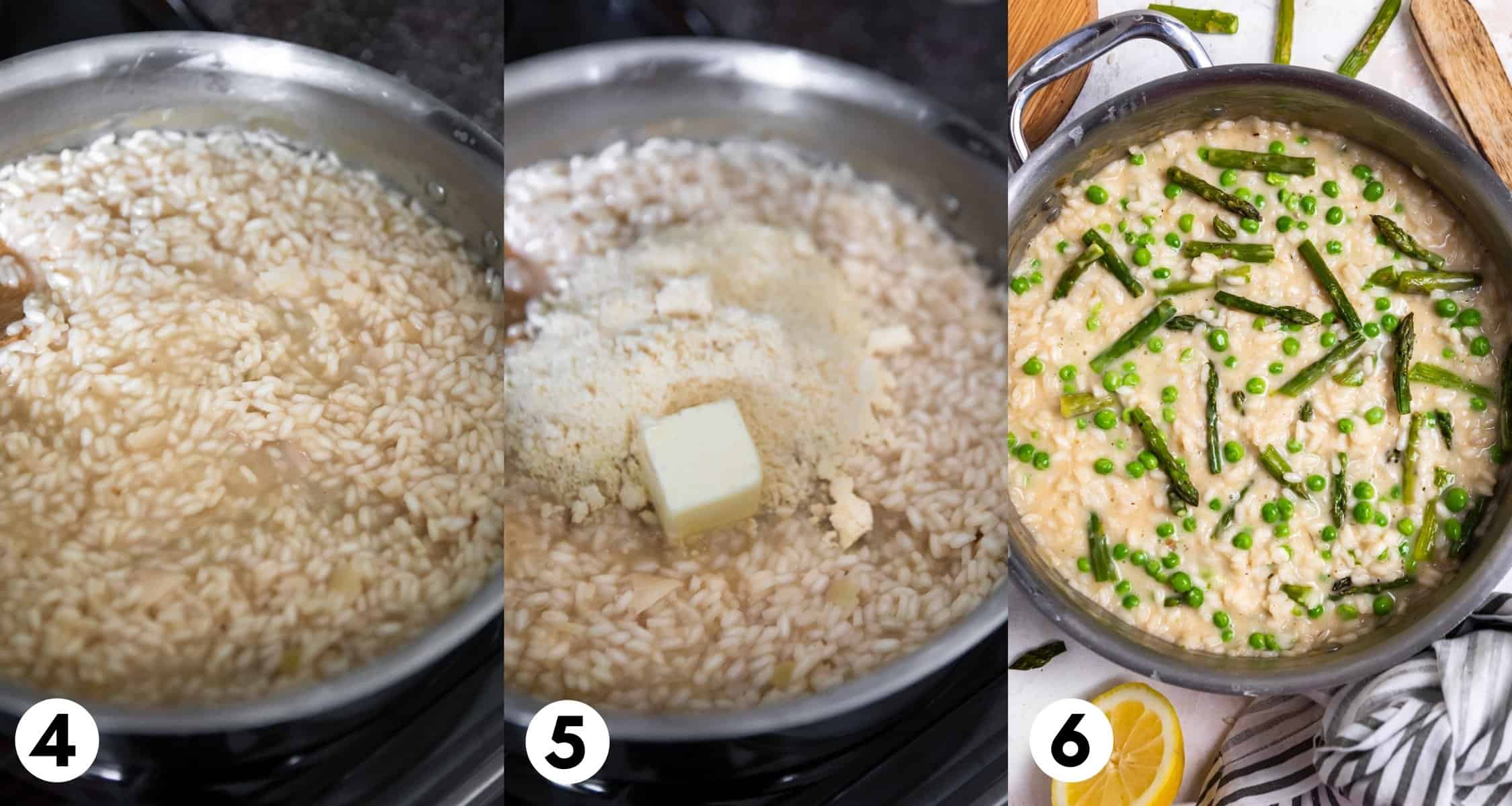
Chef’s Tips for the Best Risotto:
- Stay near the stove at all times. This is the one thing that makes risotto a bit more challenging. You don’t want the pea and asparagus risotto to come to a boil while cooking this. Risotto is the most successful when you are nearby!
- Don’t rush the process. The key to good risotto is all in being patient. Don’t add more broth to the rice until the current broth is nearly fully absorbed. Too much broth too soon can cause the risotto to be mushy.
- Have extra broth on standby. I always make sure to have about 5, possibly more, cups of broth warmed up to make sure I have enough. You can use water if you run out of broth, but for the most flavor, broth is key.
- Stir the risotto often, but not constantly. If you stir your risotto too much, you will add too much air and it will become gluey. The key is to add movement to the rice to help release the starch that will make for creaminess, but not too much that the texture is not right.
- Don’t use a pan that is too wide. About 8-10 inches is great. If your pan is too wide, the rice layer will be too thin and they won’t work with each other enough to generate the starches needed for the risotto recipe.
How to Store Your Risotto:
This pea and asparagus risotto is best served fresh but if you have leftovers, here are some tips.
Store the risotto in an air tight container in the refrigerator for up to 5 days. When it is cooled, it will thicken so add an extra splash of broth when reheating. You could add some milk or cream if you don’t have more broth available.
Risotto doesn’t freeze well so I don’t advise doing it.
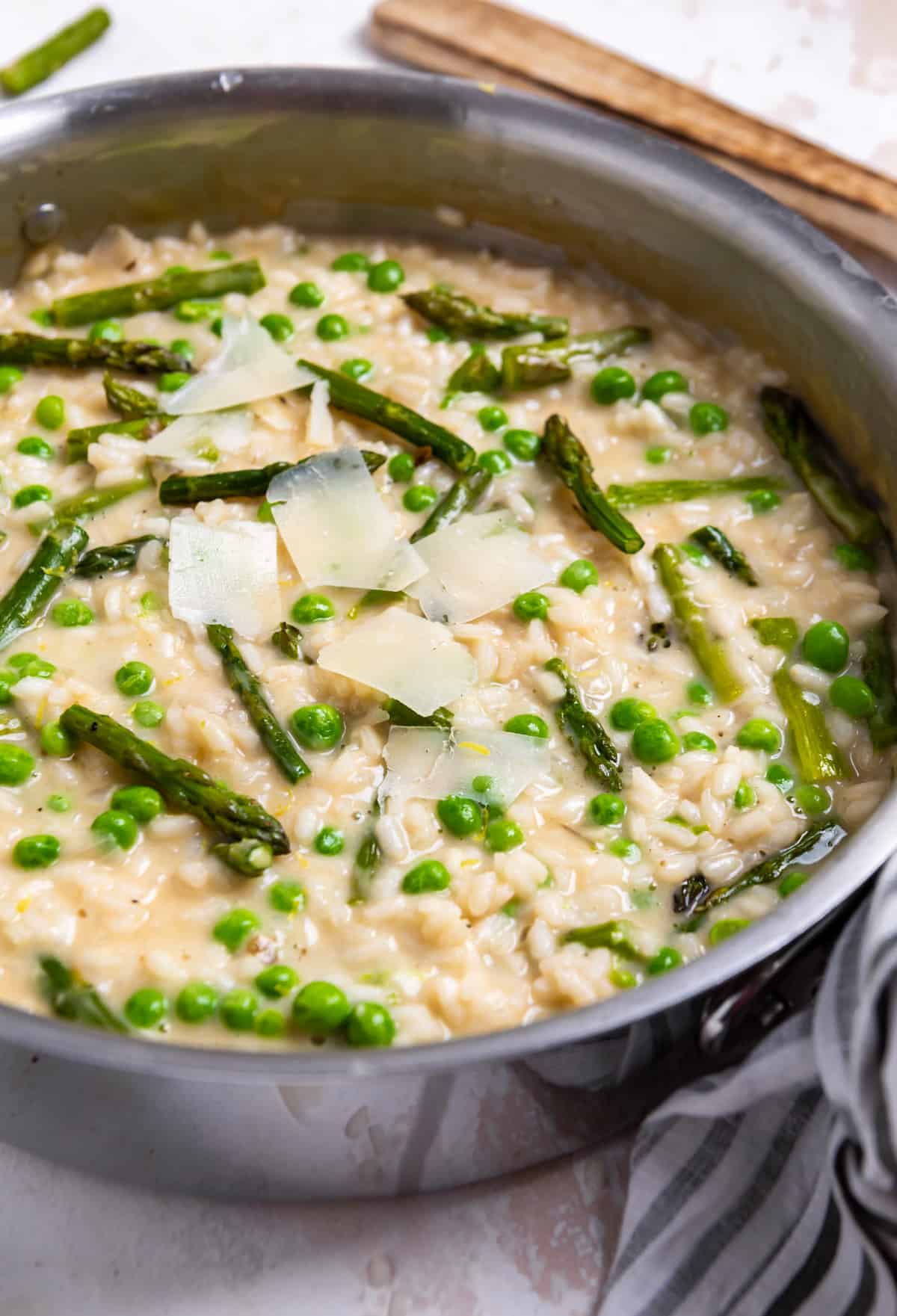
Roasted Asparagus Pea Risotto Variations and Add-Ins:
Here are some fun ways to vary this asparagus risotto:
- add sautéed sliced mushrooms
- stir in chopped basil when adding the parmesan
- use a cheese mix that includes romano, peccorino, asiago or other similar cheeses
- add a teaspoon of Italian seasoning
- add sliced and cooked chorizo, chicken or salmon
Other Simple Dinner Recipes:
- 20 Minute Lemon Ricotta Pasta
- Tortellini Caprese Pasta Salad
- Green Chicken Enchiladas
- Pumpkin Ricotta Pasta
- Creamy One Pot Pasta
- Avocado Pesto Pasta
HUNGRY FOR MORE? Subscribe to my newsletter and follow me on Facebook, Instagram and Pinterest for all the latest!
Simple Pea and Asparagus Risotto
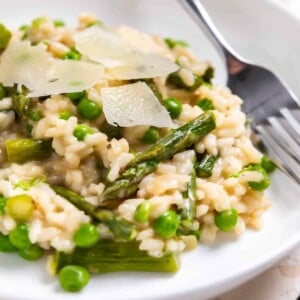
Ingredients
- 1 bunch asparagus (about 3/4 pound), chopped to 1 1/2 inch pieces
- 1 T olive oil
- 4-5 c broth
- 3-4 T unsalted butter, divided
- 1 shallot, minced
- 2 garlic cloves, minced
- 1 c arborio rice
- 1/2 c white wine
- 2 tsp lemon juice
- 1/2 c parmesan, more for topping
- 1 c peas
- Salt and pepper to taste
- Lemon zest, as desired
Instructions
- Preheat oven to 425°F. Toss chopped asparagus in olive oil and season with a dash of salt, pepper and garlic powder if desired. Roast the asparagus for about 15 minutes, until tender and starting to slightly brown. Remove from the oven and set aside.
- Warm about 5 cups of broth or stock in a sauce pan to a simmer at medium heat.
- Melt 2 tablespoons butter over medium heat in a separate pan (straight sided skillet or dutch oven work well). Add shallot and sauté for 2-3 minutes or until shallots begin to become translucent. Add in garlic and cook another minute.
- Add arborio rice and stir constantly to coat and toast for about 1 to 2 minutes. Add in white wine and allow to absorb into the rice, stirring frequently.
- Begin adding one ladle full of heated broth into the pot and stir occasionally letting the broth fully absorb into the rice. Continue adding ladles of broth one at a time, allowing them to fully absorb before adding another until the rice is al dente, soft and chewy with a very slight bite in the center. This will take roughly 20 minutes, more or less. Adjust heat to keep the risotto at a constant simmer.
- When the rice is al dente, add one more ladle of broth, remaining butter, parmesan, and lemon juice and stir constantly until smooth and creamy but not soupy. Add in the peas and roasted asparagus and stir until peas are cooked.
- Add lemon zest and freshly chopped parsley over top. Serve immediately with extra parmesan on top.
Notes
- Stay near the stove at all times. This is the one thing that makes risotto a bit more challenging. You don’t want the pea and asparagus risotto to come to a boil while cooking this. Risotto is the most successful when you are nearby!
- Don’t rush the process. The key to good risotto is all in being patient. Don’t add more broth to the rice until the current broth is nearly fully absorbed. Too much broth too soon can cause the risotto to be mushy.
- Have extra broth on standby. I always make sure to have about 5, possibly more, cups of broth warmed up to make sure I have enough. You can use water if you run out of broth, but for the most flavor, broth is key.
- Stir the risotto often, but not constantly. If you stir your risotto too much, you will add too much air and it will become gluey. The key is to add movement to the rice to help release the starch that will make for creaminess, but not too much that the texture is not right.
- Don’t use a pan that is too wide. About 8 inches is great. If your pan is too wide, the rice layer will be too thin and they won’t work with each other enough to generate the starches needed for the risotto recipe.
Nutrition
Nutrition information is automatically calculated, so should only be used as an approximation.
Shop This Post:
 Buy Now →
Buy Now →  Buy Now →
Buy Now →  Buy Now →
Buy Now →  Buy Now →
Buy Now → 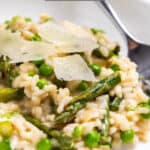
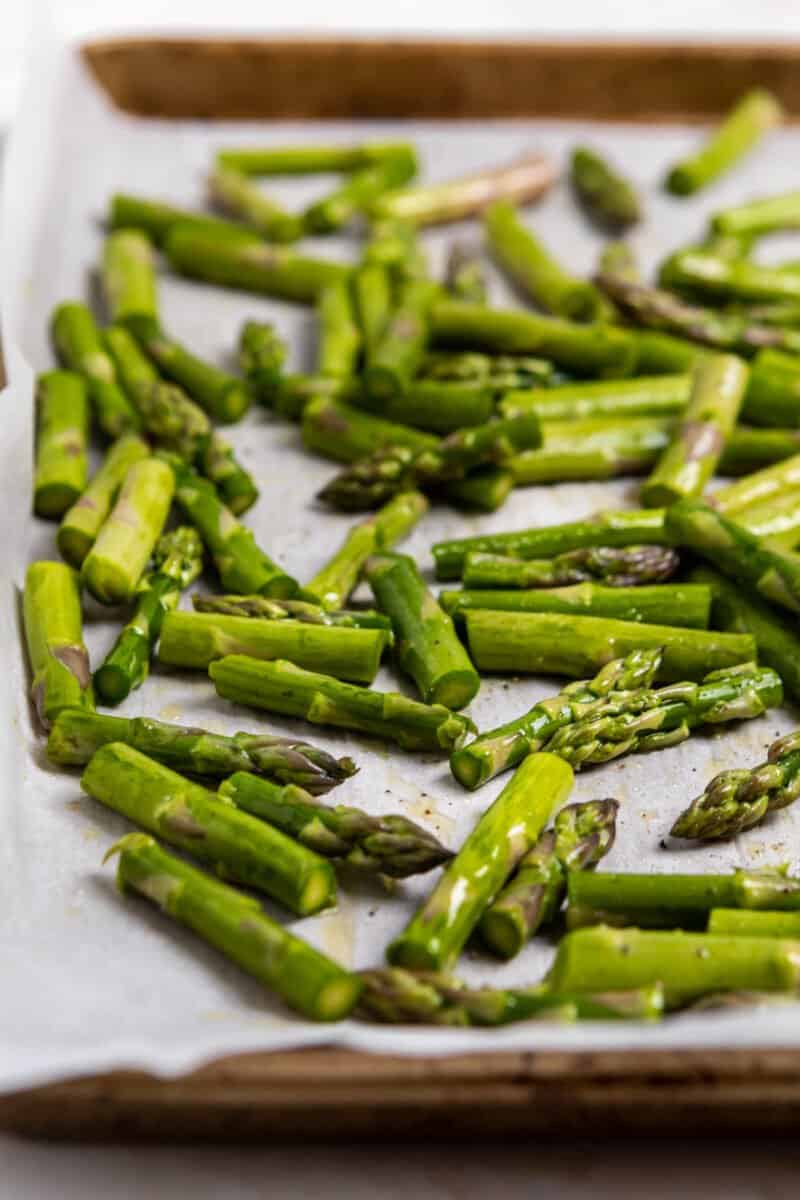
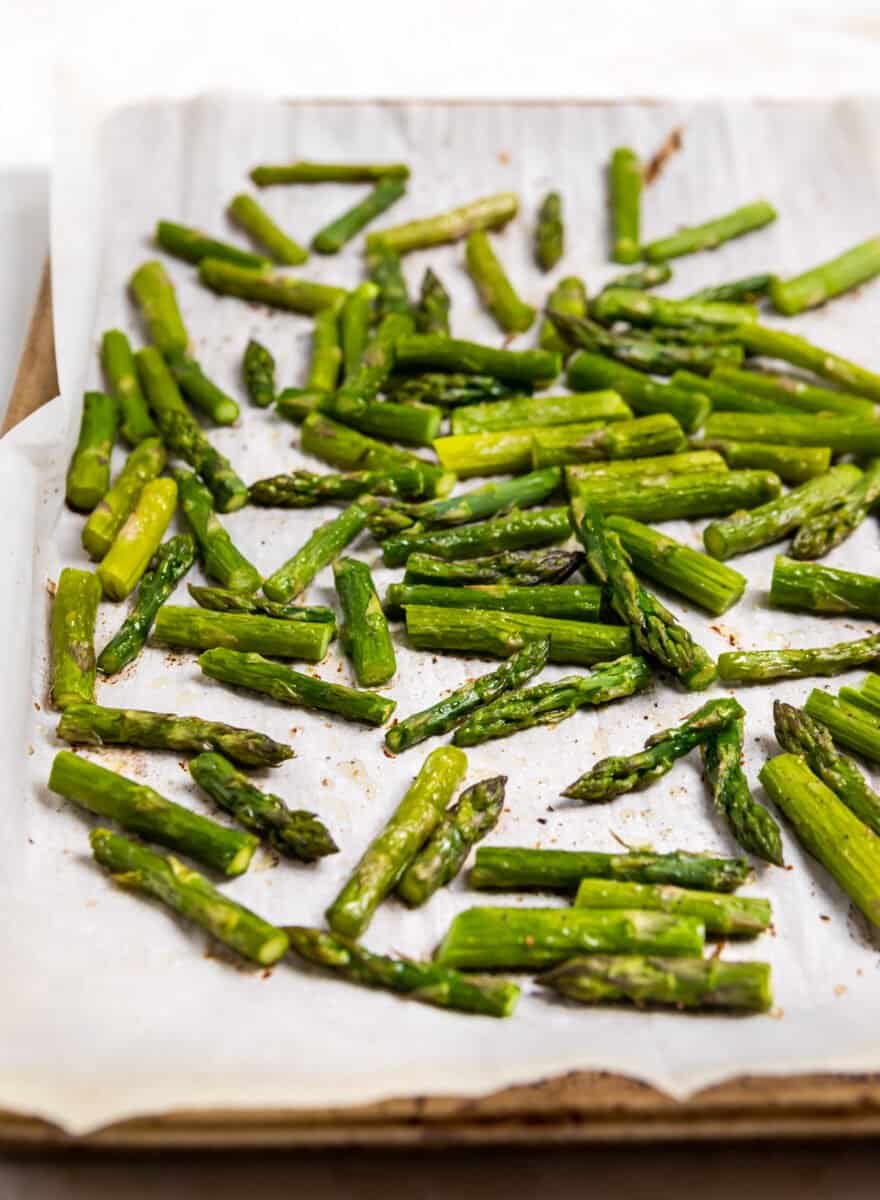









Was not creamy… not sure what I did wrong. Had to add a lot more parmesean and a little more lemon juice and zest for flavor.
Risotto is certainly not foolproof, sometimes subtle things can cause it to dry up a little more. Sorry to hear it!